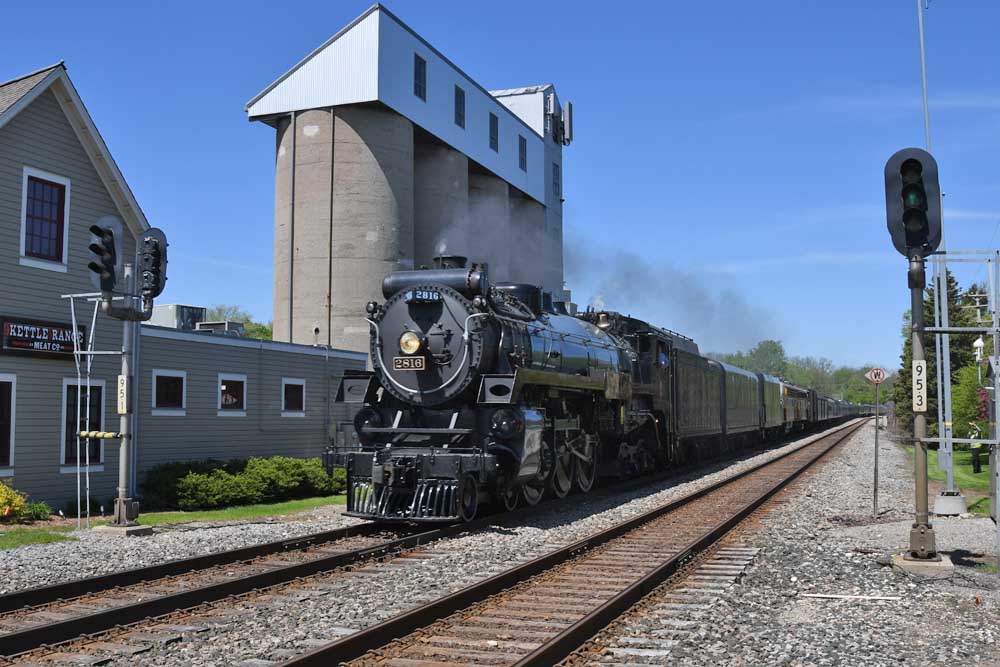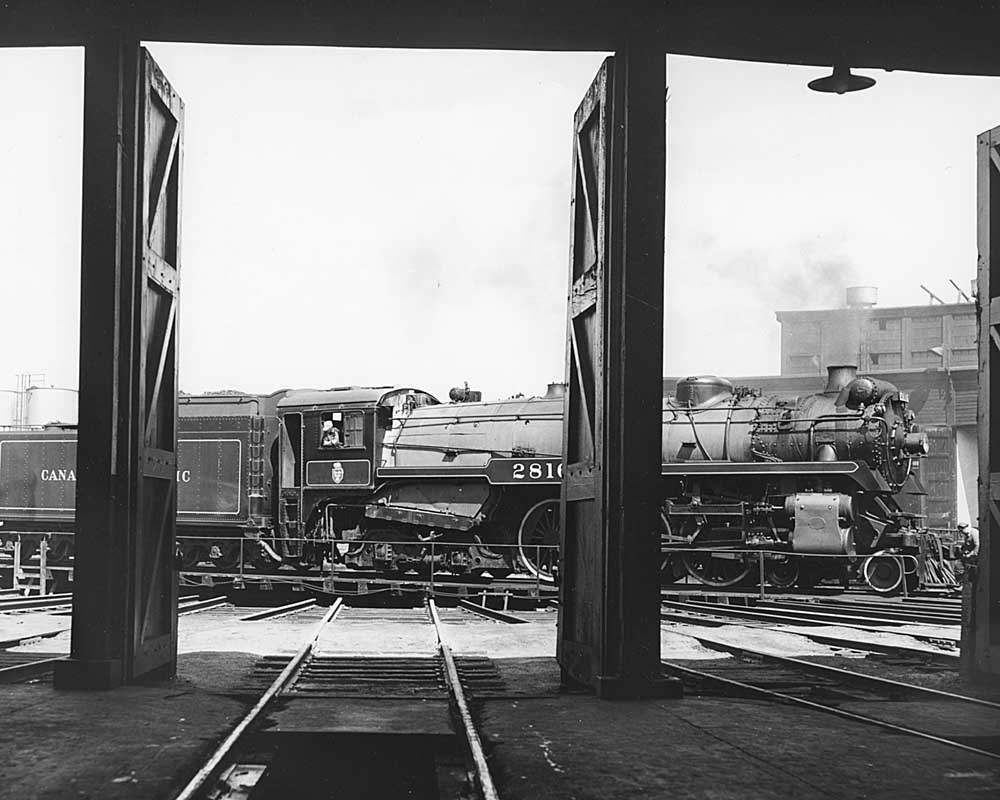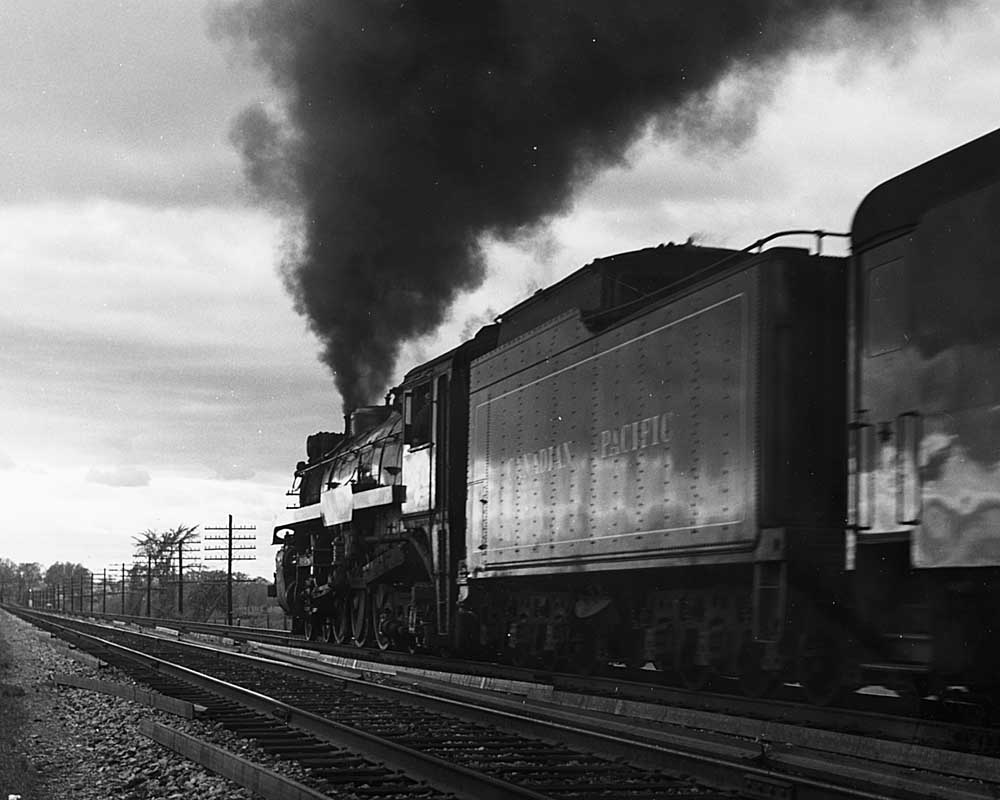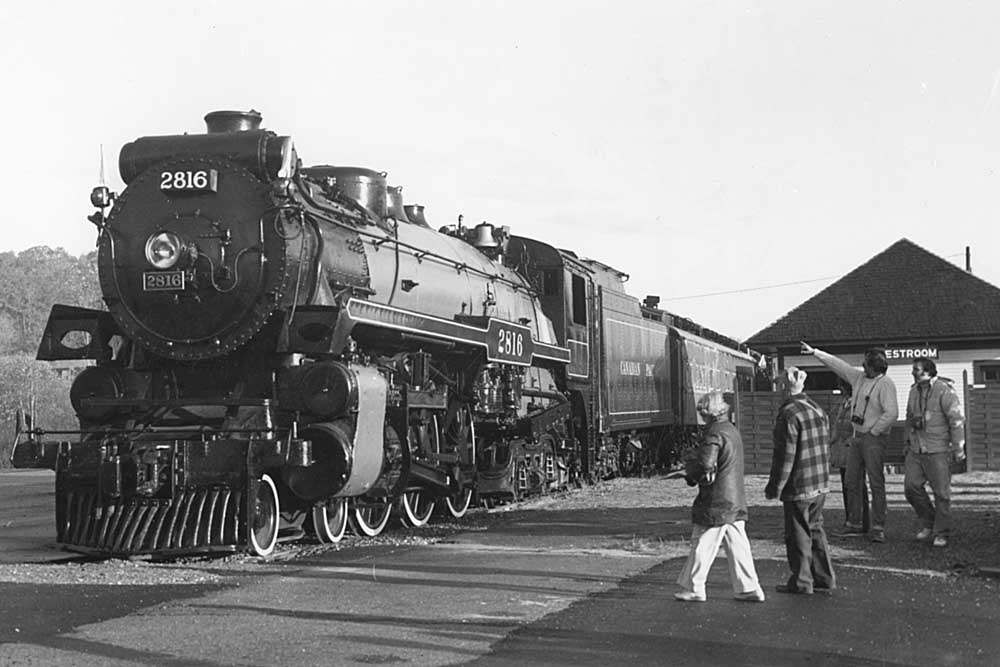
With sunny skies and warm temperatures, there was only thing to do around Milwaukee this past Monday: chase (as best you could) the high-flying Canadian Pacific 4-6-4 No. 2816, deep into its closely watched “Final Spike Anniversary Tour,” organized by CPKC to celebrate the April 2023 merger of Canadian Pacific and Kansas City Southern. The tour extends through several more weeks across Canada, the U.S., and Mexico before tying up in Winnipeg on June 30.
We don’t get much steam around here — especially of the mainline kind — so this brief Wisconsin visit by a machine known as “The Empress” was not to be missed. Several hundred railfans as well as local folk had the same idea.
Brief it was. I initially set up to shoot the 2816 in the leafy western suburb of Elm Grove, where the double-track CPKC main (former Milwaukee Road) cuts through town at a southeasterly angle. I found a spot where I could work in the local grain elevator, a nicely preserved reminder of Elm Grove’s pre-suburban history.
After an hour or so wait — the train originated in Portage, 83 miles west — the 2816 suddenly announced itself with an authoritative whistle and raced past in a matter of moments, its 75-inch drivers and Walschaerts valve gear a flurry of motion. You couldn’t help but be thrilled, not only by the gorgeous locomotive but also by the spit-and-polish maroon passenger train in its wake.

I caught the engine one more time, at a grade crossing about 20 miles south of Milwaukee, and within moments it disappeared around a distant curve, racing for public display in the Chicago suburb of Franklin Park. Then it would be on to Davenport, Kansas City, Shreveport, Laredo, and Mexico City.
Although this encounter with 2816 was momentary, I’d witnessed the 4-6-4 before, back in 2007 when it made a U.S. tour, and from that moment on I counted myself among its admirers. The 2816 is an old engine — one of 20 in the H1a and H1b class built by Montreal Locomotive Works 1929-1930 — but the CPKC crew’s meticulous restoration and maintenance has it running like a new machine.
Watching it fly past at Elm Grove, I was struck again by the enduring appeal of Canadian steam. The locomotives of Canadian Pacific and rival Canadian National weren’t all that different from American engines, and the two major Canadian builders — MLW and Canadian Locomotive — had primary relationships with, in order, U.S. companies Alco and Baldwin. But Canadian steam has distinctive traits, all of them visible on the 2816, from its classic vestibule cab to its tasteful lack of exterior piping to the prominent Elesco feedwater heater forming its brow.
Don’t underestimate the appeal of that Elesco. In fact, none other than David P. Morgan posited it as the essential detail of not only the 2816 but of much Canadian steam in general. “Seemingly, if not quite in fact, every new CN or CP locomotive constructed after 1925 bore an Elesco,” wrote Morgan, “either unashamedly hung out over the headlight for all to see or sunk almost out of sight in the upper front end of the smokebox. … It was this bundle-type auxiliary more than any other external characteristic which lent the Canadian locomotive an air of authority and size quite out of proportion to its statistics.”

The 2816 certainly had that authoritative air as it cruised through Milwaukee. I thought, “steam can’t get much better than this.” But later, digging into my reference books, I also discovered this earliest version of the CP Hudson didn’t always get the respect it deserves. Morgan barely mentions it in his opus “Steam’s Finest Hour” (Kalmbach, 1959), ditto William L. Withuhn in his “American Steam Locomotives” (Indiana University, 2019). And in Morgan’s wonderful “Canadian Steam” of 1961, not a single H1a makes the cut among the book’s 91 featured photographs.
The “blame,” of course, is on the last three batches of 45 CP 4-6-4s, the H1c, H1d, and H1e “Royal Hudsons,” built by MLW 1937-40 and famous for their semi-streamlining, which consists of a recessed headlight, a solid pilot, even cleaner piping than the earlier Hudsons, and a domeless boiler profile. Oh, and also for their role in hauling King George VI and Queen Elizabeth around the Dominion in 1939. The revivals of Royal Hudsons 2839 and 2860 in the 1970s and ’80s sealed their fame.
I chased or rode behind all of these engines one time or another and was suitably impressed at every encounter (the 2839 did a nice job standing in for a Southern steamer in the 1980 movie “Coal Miner’s Daughter”). But having witnessed the 2816 again, I have to say I prefer its traditional appearance. I was never a fan of the Royal Hudsons’ flat face, reminiscent as it is of Gort. Give me the 2816’s traditional headlight.
Every steam locomotive that has survived into 2024 has a convoluted story to tell, and the 2816 is no exception. Credit goes to F. Nelson Blount, who included the 4-6-4 in the scores of locomotives he acquired for the original Steamtown museum in Bellows Falls, Vt. The engine wouldn’t be here today without him. Then came former CP President Robert Ritchie, who purchased the engine in 1998 when Steamtown’s new operators in Scranton deemed it surplus. And now we can celebrate CPKC management’s good judgment in allowing 2816 to do its thing. (For a full account of CP’s 4-6-4s, see James A. Brown’s and Omer Lavallée’s sprawling “Hudson Royalty” article in the August 1969 issue of Trains.)
If you’re fortunate to be in the path of the “Final Spike Anniversary Tour” as it plays out in the coming weeks, don’t miss the opportunity. In so many ways, the 2816 is the essential Canadian locomotive, fulfilling, in Morgan’s words, “as inimitable an appearance as ever stamped a road’s roster in our time.”














